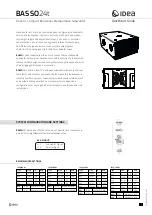
13
Frequently asked questions
Last updated: January 19, 2023 05:57. Revision #10620
What is meant by speaker sensitivity?
Speaker sensitivity is the level produced by the speaker at one meter, when supplied with one watt of power from an amplifier. It’s a way of
describing how well the speaker produces acoustic energy, based on a given input. The level is measured in dB SPL – this shorthand for ‘sound
pressure level’ – sound is basically fluctuations in air pressure, so any time you see SPL, this means ‘sound in the real world’. So, let’s say we have a
speaker with an 87dB sensitivity, and a speaker with a 90dB sensitivity – the 90dB speaker is going to be considerably louder, as every 3dB added
represents a doubling of power.
What is a crossover?
Most speakers will have multiple drivers. A driver is sometimes called a transducer, which is a device that turns one type of energy into another – in
this case, electrical energy to sound energy. In a loudspeaker, it is often the case that we might want multiple drivers – one to handle low-end, one
to handle the mid-range, and one to handle the treble. This latter driver is often called a tweeter. To get the benefit of this arrangement, we need to
split the signal into different frequency components. The circuit that does this is called a crossover.
What is impedance?
You will often see impedance mentioned when researching speakers, and amplifiers. Impedance is basically resistance measured at a given
frequency, given as a value in Ohms (Ω), and is incredibly important to consider when setting up an audio system as it determines the ‘load’ placed
on an amplifier by the speakers.
For example, let’s say we have an amplifier that is rated to deliver 100W into an 8Ω speaker load. If we were to then use speakers with an
impedance of 4Ω with the same amplifier, the amp would then need to supply 200W as a halving of the impedance results in a doubling of the
required power due to the reduction of the load on the amplifier.
In a situation such as this, if the amp can’t supply the required power for a lower impedance, then it can result in overheating, and damage to the
amplifier and speakers.
For this reason, it is important to pay attention to amplifier specifications, and suggested impedance ratings.
































